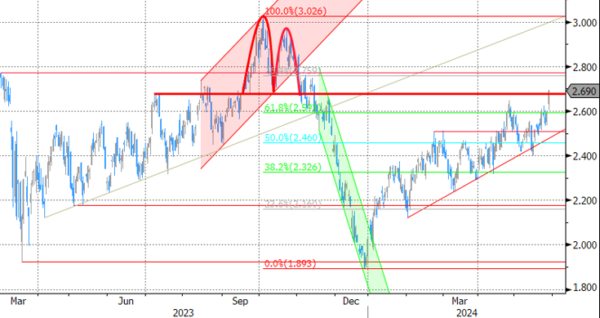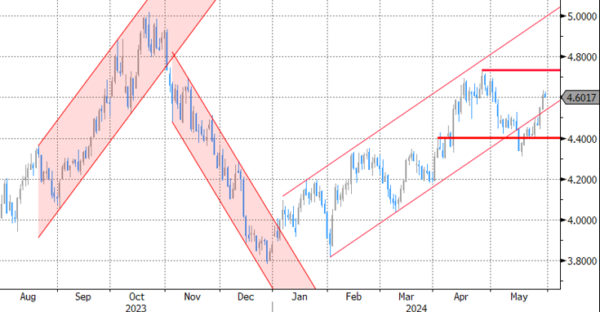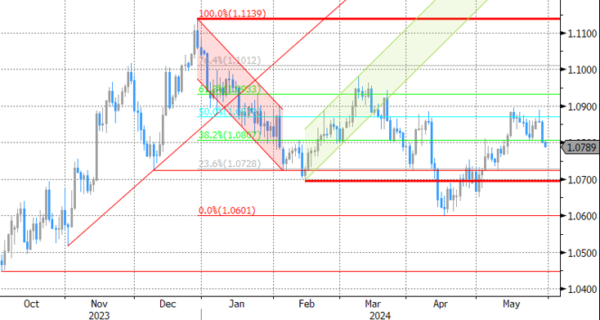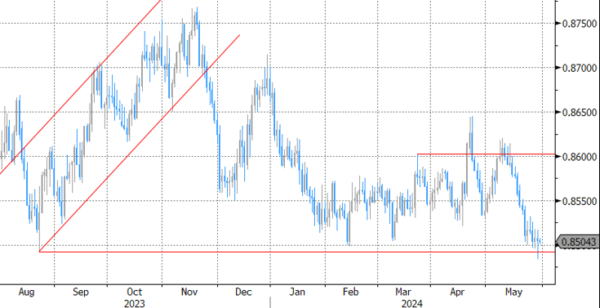Markets
LT yields yesterday continued recent reacceleration. This tells at least as much on current market momentum as on the news that served as an explanation. Regional German May inflation published throughout the day were soft (0.1% M/M). At 0.2% M/M HICP inflation also decelerated markedly (0.6% in April), but due to base effects, Y/Y inflation jumped from 2.4% to 2.8%. It was enough especially for LT German/EMU yields to decisively turn north again. The German 10-y yield pierced the 2.65% YTD top. US Treasuries outperformed Bunds, but in US dealings the Treasury’s $44 bln 7-y Note auction again met mediocre investor appetite, reinforcing the bearish bond market momentum. In a steepening move the 30-y yield gained 6.7 bps. German yields added between 3.2 bps (2-y) and 9.3 bps (10-y). The rise in (real) yields this time didn’t go unnoticed by equity investors. Both European (Eurostoxx 50 -1.33%) and US indices eased from recent (near) peak levels (S&P 500 -0.74%). The dollar finally profited from tighter financial conditions combined with a risk-off sentiment. DXY is testing last week’s top at 105.11. In a similar move, EUR/USD dropped from 1.0857 to 1.0801. USD/JPY regained the 157 barrier, but is nearing suspected yen intervention territory. EUR/GBP briefly touched a new YtD low below 0.85 on initially soft German regional inflation data, but rebounded later to still close at 0.8504, even as UK yields rose even more compared to their German counter parts (up to 12 bps for ultra long maturities).
This morning, Asian equities join the interest-rate driven setback on WS yesterday. US yields ease marginally after yesterday’s sharp rise. In a speech, Atlanta Fed President Bostic indicated that, while there is still some way to go, several inflation measures are moving to the target range. Even so, he still concluded that it might take till the end of the year/Q4 to think about/being prepared to reduce rates. The dollar mostly holds yesterday’s gains. USD/JPY is an exception dropping to 156.9 as yen shorts turn more cautions on possible yen interventions. The eco calendar today contains EC confidence data and some national EMU inflation data ahead of tomorrow’s EMU Flash estimate. Fed’s Williams and Logan are scheduled to speak. Even with a rather light calendar, we continue to keep a close eye at LT yields. The US 10-y yield is moving decisively higher in the 4.37%/4.73 trading range. The German 10-y already broke 2.65% resistance. The EMU 10-y swap is nearing similar resistance at 2.95%/3.02%. EUR/USD breaking below the 1.08 support area/neckline, might trigger return action to the 1.0724 ST support.
News & Views
Outgoing president of the Swiss National Bank Jordan flagged the weaker franc is the most likely source of higher Swiss inflation. Prices in April rose 0.3% m/m and brought the yearly figure to a higher-than-expected 1.4% from 1% in March. Core inflation reaccelerated too from 1% to 1.2% on a 0.4% monthly increase. The franc meanwhile lost considerable ground. After hitting a record high (barring the intraday levels seen during the repositioning after the SNB lifted the EUR/CHF 1.20 price cap) around 0.93 at the start of 2024, the franc slipped all the way towards 0.99. While EUR/CHF 0.93 clearly was a too strong level for the SNB, the opposite seems now to be true. Jordan said the central bank could move towards selling FX to support the franc. SNB was the first to cut rates (unexpectedly) back in March from 1.75% to 1.5%. While another cut in June long seemed likely, the risks for postponing to September after Jordan’s intervention have clearly risen. Swiss money markets currently attach a 50% probability to a June rate cut. The Swiss franc noticed Jordan’s speech and strengthens to EUR/CHF 0.984 after a good (risk-off) run yesterday.
The New Zealand government announced a tax cut package worth NZ$ 14.7bn over four years. Doing so, the center-right policymakers make good on promises made in the run-up to the 2023 elections. Finance minister Willis said that the changes will be fully paid via savings and revenue initiatives instead of additional borrowing. It does however mean the start of fiscal consolidation will be delayed to 2028 instead of 2027 as envisaged in December. Budget deficits will be deeper as tax collections because of the announcement as well as slower growth will turn out to be lower than previously expected. Debt to GDP is seen peaking at 43.5% next year and will barely decline through 2028. In response to today’s budget presentation, New Zealand Treasury updated the bond programme. It expects to issue an additional NZ$ 12bn over the next four years, bringing total gross NZGB issuance to NZ$ 164 bn.
Graphs
GE 10y yield
ECB President Lagarde clearly hinted at a summer (June) rate cut which has broad backing. EMU disinflation continued in April and brought headline CPI closer to the 2% target. A more bumpy inflation path in H2 2024, the EMU economy gradually regaining traction and the Fed’s higher for longer US strategy make follow-up moves difficult. Markets are coming to terms with that. The 10-y is setting a new YtD top.
US 10y yield
The Fed in May acknowledged the lack of progress towards the 2% inflation objective, but Fed’s Powell indicated that further tightening was unlikely. Soft US early month data triggering a correction off YTD peak levels. However, the Fed minutes still showed internal debate whether policy is restrictive enough. Sticky inflation suggests any rate cut will be a tough balancing act. The US 10-y yield is rebounding in the 4.30/4.70% trading range.
EUR/USD
Economic divergence, a likely desynchronized rate cut cycle with the ECB exceptionally taking the lead and higher than expected US CPI data pushed EUR/USD to the 1.06 area. From there, better EMU data gave the euro some breathing space. The dollar lost further momentum on softer than expected early May US data. Some further consolidation in the 1.07/1.09 are might be on the cards short-term.
EUR/GBP
Debate at the Bank of England is focused at the timing of rate cuts. Most BoE members align with the ECB rather than with Fed view but slower than expected April disinflation and a surprise general election on July 4 complicated matters. A June cut in line with the ECB looks improbable. Sterling extends a recent bull rally. A test of EUR/GBP’s 2024 YtD low (0.8489) is possible. We expect this important support level to hold.


















